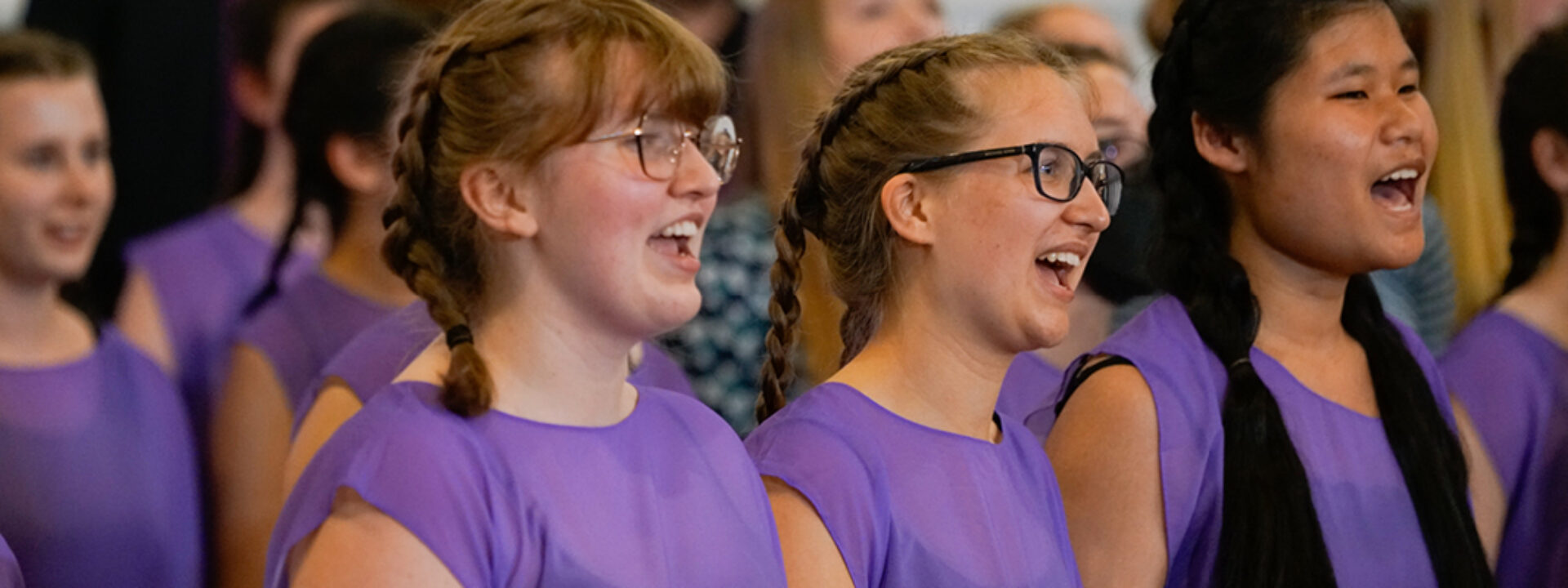Pitch Perfect

The Hamilton Children’s Choir has a long history, an international reputation and is now embarking on a new future of song.
It’s rehearsal night and the first chorister arrives early, clad in running shoes, her black hair clipped back. “I’m Ella,” she announces. She walks over to a stack of red chairs. “They have to be in rows of 13,” she explains, laying out the chairs in carefully spaced rows.
The relative quiet inside the band room of Hillfield Strathallan College is interrupted by the clatter of arriving Hamilton Children's Choir (HCC) singers. New artistic director Melanie Tellez strides to the centre of the room, one hand poised above her head. “Can we have your first pitches, please?”
The choristers begin, the harmonies unfurling, filling the room. “Beautiful sound!” Tellez cries.
And so begins the first rehearsal of Ilumini, Hamilton Children’s Choir’s primary performing ensemble and the only HCC choral program that requires an audition. With two rehearsals a week and a commitment to practising at home between rehearsals, the life of an HCC chorister is equal parts demanding and rewarding.

HCC is a community-based children’s choral music education program that welcomes any young person with a love of singing. Now in its 48th year, it offers six progressive choral education and performance programs currently enjoyed by almost 200 young singers between the ages of four and 24.
For nearly 20 years, the HCC drew international acclaim under the leadership of Zimfira Poloz, whose passion and skill transformed the artistic and educational approach of the choir. Earlier this year, after an international search, Tellez stepped in to usher in a new chapter of the HCC.
“Measure 40, please.” She scans the faces. “What are the first sopranos singing?”
“The fifth!” one chorister calls out enthusiastically.
Tellez’s evolution to artistic director was years in the making. A member of HCC’s artistic team since 2010, she served as assistant director since 2015 until taking the reins from Poloz and becoming the primary architect of the choir’s renowned pedagogical and performance model.
“I started with younger singers and worked my way through the choirs developing theory and sight singing for the music education side. I’ve also dabbled in the artistic creation,” says Tellez, “doing some original choral narration performances, where I’ve taken a script for a story or myth and created a concert program weaving together pieces that are completely unrelated otherwise.”
In the front row, a young girl raises her hand. “Could I just hear the pick-up into the bar?” she asks. Tellez nods to the pianist, Brent Fifield, and leads them through the phrase again. “Make sure the F sharp is in tune,” she says.
For Tellez and executive director Trish LeClair, the choir’s success lies in providing a nurturing environment – with plenty of positive energy.
“Sometimes our young people don’t feel accepted or supported in other parts of their lives. Here, they’re able to be themselves, so they relax and blossom,” LeClair says. “The friendships happen during the singing and in between the singing, too.”
Watch: HCC was the only Canadian choir invited to perform at the 12th International Youth Choir Festival in South Korea in 2014
During the break, choristers offer their thoughts on being part of HCC:
“We all go at each other’s pace,” says Tommy Humeniuk. “It’s a community.”
“I love the environment of choir and hearing everyone’s ideas. It’s a safe space and that’s a really cool thing,” offers Alexandra Lima.
“OK, everybody,” Tellez signals for them to return. “Anyone want to try the solo line? Someone feeling brave?” She flashes a smile, but there are no takers. She tries again. “How about the group leaders?”
The singers begin, bodies moving in tandem, heads bobbing, hands tapping thighs. Apart from stellar vocal skills and a good ear, the choristers must be able to learn complicated choreography.
“There’s a belief that choral tradition that comes from England is ‘Stand in the road and sing,’” Tellez explains. “But it’s so much more. Choreography is an evolving practice; you’ve got to be aware of what types of movement serve the music. And the singers’ connection to their bodies is alive and moving in the way they sing through a phrase. It’s a tactile response.
“We’ve learned so many things from different choreographers and dance instructors. It’s the type of alchemy you want in collaboration.”
One of her goals is to create partnerships within the city.
“There’s a bravery here in Hamilton, a willingness to be bold and try new things,” Tellez continues. “We want the city to be more fully represented in our choir, and that means some rethinking – what does the word ‘choir’ mean to people? It can be such a distant concept. But any child who wants to do this can – there’s no magic to it, no secret gift.”
Their plans include building on an already stellar reputation.
“Our reputation came about because of Zimfira and her profile and relationships internationally,” says Tellez. “It allowed our singers to experience a remarkable cultural exchange that many of them haven’t experienced. We want to keep touring, to build bridges that are meaningful.”
That includes continuing a collaboration with the Hamilton Philharmonic Orchestra.
“You know, it’s not just a job,” she continues. “It’s a transformative experience for us all. And some days, music is that place. You need it and you crave it. And then there are those days when you didn’t know you needed it at all.”
She cues the choristers, and the lush strains of “Esto Les Digo” rise and swell, filling the room.













